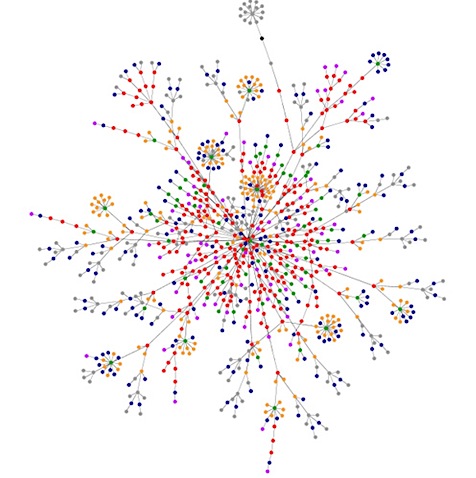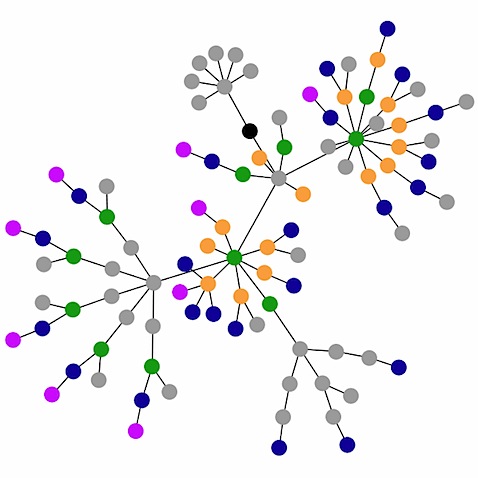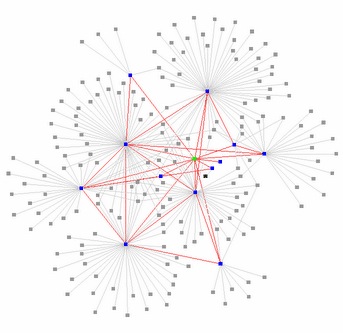You’ve heard about the Social Graph and the Interest Graph. Now meet the Identity Graph— the online network of the authentic, social, interpersonal you.
Different kinds of relationships create different graphs.
Each of us has our own social network that’s comprised of a hodgepodge of different kinds of connections. We have social connections between neighbors, college friends, and second cousins, which we capture online on sites like Facebook. This portion of our digital network is our social graph¹.
We have connections among coworkers from other jobs, folks we’ve met at conferences, and ‘business friends of business friends’ organized on LinkedIn, collected inside our organization’s enterprise communication platform, and managed by our professional work communities. This portion of our digital network we call our professional network or career graph.²
 And, out there on Twitter, Tumblr, Quora, IfWeRanTheWorld, and so on, we’ve got our connections among folks who care about LOLcats, The Weepies, #SHEtalkTED, and an array of personal causes and individual interests. This is our interest graph.
And, out there on Twitter, Tumblr, Quora, IfWeRanTheWorld, and so on, we’ve got our connections among folks who care about LOLcats, The Weepies, #SHEtalkTED, and an array of personal causes and individual interests. This is our interest graph.
Our Identity Graph
The Identity Graph is a shimmering vibrant web of online relationships and shared energies that exists on top of and is embedded within other graphs. Composing this graph are the people and the connections across which we act in ways that express “what it means” to be who we are.
The Identity Graph shows us the online relationships where we enact, demonstrate and experience who we really are. We share valued parts of our selves and continually create personal meaning, in interactions where we bring our authentic selves to the fore.
Different Graphs <= Different Use
We create these different graphs because we use online tools for different purposes. Our social graphs come from sharing real-world social connections with people we know, our professional graphs are created as we get work done, and our interest graphs come from pursuing ideas, situations, places, and activities that interest us. These graphs are not independent… you probably have ‘real life’ friends who share your interests and folks you know from work who have become Facebook friends.
Different Graph => Different “Us”
Over the course of any given online day, we skip from one digital platform to another, listening, sharing and responding to communications with people across our network. Some of these interactions occur in our social graph, some in our professional graph, and some in our interest graph. In an ideal world, many of these interactions would overlap with your identity graph, indicating that across your online social world, you felt authentic some of the time.
We feel different, we are different, across these interactions.
As we interact across these graphs, our “selves” shift. We adjust how we present ourselves, and the ways that others receive and respond to our selves also shifts.
In some interactions, ‘who we are’ is completely visible and apparent. In other interactions, our individual personhood is shrouded or subsumed by a persona relevant to that situation but not necessarily expressive of our authentic selves. We are recognized or ignored, understood or misheard, and ‘there’ or ‘not quite fully there’. Some interactions move a task ahead, while others bring out the best in us and challenge us to grow. Still other interactions do both.
You’d think that ‘who you are’ and what it feels like in each of these interactions would depend on which graph you’re working in– you might assume you’d be more ‘real’ in your social graph than in your professional graph, or more real in your interest graph than in your social graph.
But that’s not necessarily so — you’re more ‘real’ in your ‘identity graph’ — when you are engaging in relationships where the person/ality you are called upon to be is the person most like how you actually see yourself. Your identity graph is the relationships where, online, you get to be “you”.
What it’s like in the Identity Graph

Interacting within your identity graph is personally engaging, rewarding, and growth-challenging. At the most basic level, when we are able to interact authentically, we are able to be more resilient, more flexible, more creative, and more growth-oriented. We are operating from our core identities, so our actions are rooted in our indigenous personal characteristics. Our actions flow smoothly, because we don’t have to filter them or crimp them to fit.
You can feel that you’re in your identity graph when a tweet pings your heart, a subject line makes you drool, and the very name on the email makes you look forward to reading it. I bet I’m not the only person who, when my energy flags, turns to scan her feeds and timelines looking for connection opportunities that, once engaged, will help me get my authentic mojo back.
(This is one of the reasons we’re so hooked on email and Twitter– we keep hoping, just hoping, that we can have an authentic interaction or two to keep our days meaningful.)
But you also love working within your identity graph because it’s meaningful to you. The people you are interacting with, whatever it is you are communicating, and the “who that you” all matter. You are contributing the authentic you to the other person(s) in the relationship, to the project you’re working on, or to the interest that you share. The more you are able to be who you are in an interaction, the more you are able to create meaning for yourself as well as for others.
Try this little experiment:
Over the next few days, take note of the online interactions where you feel particularly alive and authentic.
- Find 4 or 5 people from your work, interest or social graphs who, when you interact with them, call forth your authentic self.
- Put these people in their own special (secret) Facebook group, Twitter list or column.
- Then, invite yourself to step up your interaction with these people.
- Take note of how it feels when you make just a small adjustment to engage in your identity graph more often.
My bet is that you’ll find yourself being drawn to that set of people. And, you’ll find yourself shifting how you present yourself in other interactions too, adding a bit more ‘you’ to these, too. You might also notice that you can expand your identity graph by developing new relationships through and around the people in your identity graph (for example, by interacting directly with friends of friends on Twitter).
When you have a sense of your identity graph, you can use this new awareness to
— Be more you, more often, by spending more time in your identity graph
— Grow the spaces where you get to be authentic. Take advantage of serendipity (like when new people follow you on Twitter). And, apply the same techniques recommended for ‘networking’ to extend your identity graph more deliberately.
— Diagnose your online life –by looking to see where you should or could be more authentic, and developing your identity graph there.
Right now, the social networks and interactions you inhabit may or may not call out the most authentic versions of who you are. But, you can change that by changing your identity graph, to invite your authentic self to flourish.

See also:
Tweet Yourself Like The Person You Want To Be
Is your organization flourishing or withering?
Why the Interest Graph Will Reshape Social Networks (and the Next Generation of Internet Business) by Nathaniel Wittemore on Assetmap
The Future is a graph, by Chris Dixon on MEDIAite
Explaining what the “Social Graph” is to your Executives, by Jeremiah Owyang
Notes:
¹Technically speaking, your ‘social graph’ is all of your social relationships that are captured online. Above, I’m using the term more metaphorically, and more generally, as its use has evolved outside the Technical & empirical community.
² That I know of, no one has defined the professional network as a career graph (or similar) but it makes sense to distinguish this from other graphs.
Images: The web outside, Advanced Topics in Scrum, Network Weaving Blog
 I am an organizational consultant, change advocate, and organizational identity/reputation scholar with a PhD in leadership & organizations. I research, write about, and consult with organizations on the relationships between organizational identity, actions, and purpose. I teach Technology Management, part-time, at Stevens Institute of Technology.
My current research focuses on how social technologies in the workplace can drive organizational change, generate meaning, and catalyze purpose. See the
I am an organizational consultant, change advocate, and organizational identity/reputation scholar with a PhD in leadership & organizations. I research, write about, and consult with organizations on the relationships between organizational identity, actions, and purpose. I teach Technology Management, part-time, at Stevens Institute of Technology.
My current research focuses on how social technologies in the workplace can drive organizational change, generate meaning, and catalyze purpose. See the 
{ 6 comments }
As usual, you are spot on! When I made the transition from Blogger to Twitterer I did not know if the following I had would benefit. As it turns out, I have created a new network of relationships that give more purpose to what I do. The latency of authenticity is collapsed when “real-time” interaction and reaction are re-introduced into an otherwise monolithic and impersonal social media graph.
In the old days, authenticity could be judged by looking through the eyes into the soul. Sadly, no Social media technology has been successful at replacing this.
Hi John,
Thanks so much for your comment! Your point about the ‘real-time’-ness of twitter and the intimacy of it hits home to me. I don’t kwow whether it’s immediacy, or something esle, byt Twitter feels more ‘real’ to me that other platforms…
Since I follow you on Twitter, I’ve been getting a sense of ‘who you are’ by what you RT and what links you recommend– there is a way to get at ‘who you are’ by inferring from ‘what you like’ (though, this isn’t necessarily accurate).
I wonder what we’re using as proxies to give us a sense of each other’s souls online… I’d love your thoughts on this.
cv
Why does it have to be a special, secret group, CV? I’d like to hope I’m just as authentic in public as I am in private. Bret
Hi Bret-
In the ‘experiment’, the reason to make the list secret (or rather, keep it to yourself) is so that one doesn’t bias the reactions of those other people to you. If people knew they were (or, for that matter, weren’t) on your ‘identity graph’ list, they might receive you differently and/or respond differently. So you’d want to keep it to yourself so that you don’t complicate the experiment.
It’s not so much that a person is ‘more’ authentic in private, or in public, but that people are more authentic in certain kinds of situations and relationships that others (which kinds, of course, depend on the person). Not to get too much into interactional psych here, but all the principles of self-presentation, self-affirmation, etc. all apply.
If I read you right, you’d hope that people where authentic more or less across the board in there relationships. in general, more authentic is better than less authentic, and yet there are some situations & relationships where it is actually psychologically healthier to withhold, and/or present a partial or even partly fictional image. But, these are rare-ish.
thanks for your ideas…provocative as always (authentically you?)
cv
CV,
In this post, you suggest a deeper alignment beyond our social circles and groups of interest. It’s an integration of sorts, while transcending and including that of which we are already a part of.
Most would like to think that that one is being “real” with those we associate with on-line within our networks (pollyannaish?). Oddly enough – I do think social media offers an opportunity to connect on a deeper soul level which nurtures my “inner identity” and allows me to flourish even more.
I would agree that organically there is a group of people who we might gravitate towards – in terms of authentic feedback and “brainstorming”.
Identity of the self is individual and interdependent at the same time. Kinda like the tree falling in the forest perhaps – maybe there needs to be someone there to hear and acknowledge it.
I wonder about the “real time’ of twitter however and whether it is useful or subverts authentic exchange. Are we shooting from the hip, or can we offer critical thought provoking opinion from our true identity?
For me – I’m feeling a new post coming from this …
CV – I find it very difficult to gauge Authenticity without a measurable period and multiple scenarios. There really is no proxy. Moreover, I find that a lack of a “Moral Compass” that values truth in relationships can open the door to so many ways to “game” the system AND an individual. Hence the “scandals” that break open when many inside have been aware since the inception of said situation. Much work against the better judgment and good is accomplished in the “shadows” be in Gov’t, Banking, Industry. Truth loves the light.
Comments on this entry are closed.